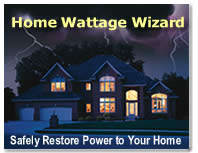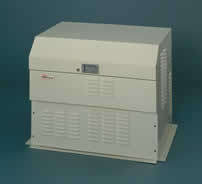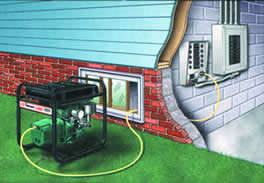GENERATOR SIZES AND TYPES FOR HOME OR BUSINESS
Home and business owners often ask us two questions:
1. What size generator do I need? and
2. Should use a portable or stationary generator for my home or business? Read each section carefully and you will see how each type of generator fits into you power backup planning.
Power Generation, What Size Do I Need?
 In the past, enduring a power outage was as simple as lighting a candle and the fireplace. Not anymore. Without electricity, basements can flood. Security systems can falter. Home businesses can fail. In the past, enduring a power outage was as simple as lighting a candle and the fireplace. Not anymore. Without electricity, basements can flood. Security systems can falter. Home businesses can fail. Many homeowners are unable or unwilling to wait out the next power outage, so they are installing backup power systems in their homes. The first step in purchasing a backup power source is figuring out how much power you need. Power generation systems are rated according to the number of kilowatts (kW) of electricity they produce. The following chart quickly summarizes how much electricity various power generators can produce. |
| Rated Watts | Description | Degrees of Power |
| 5 kW | A basic system that can restore power to multiple "survival appliances". | Four lights, furnace fan, sump pump and refrigerator/freezer |
| 6.5 kW | A small system to keep all the survival appliances operating and a few extras. | Survival appliances plus family room. |
| 8 kW | A mid-Sized system to help you weather powerless days and nights. | Survival appliances plus family room and home office. |
| 10 kW | An emergency backup power system providing comfort and security. | Survival appliances plus family room, home office and kitchen. |
| 15 kW | A powerful system with enough energy to run a small home. | Survival appliances plus family room, home office kitchen and laundry room. |
| 25 kW | A mini-power plant that can run a small to mid-sized home or business. | All of the above plus an air conditioning system. |
| 30 kW and up | A mini-power plant that can run a mid-sized to large home or business. | All of the above and more. Live in total comfort. |
For a more detailed analysis, use our interactive Wattage Requirement Guide to determine how much power you'll need during a blackout.
It's very important not to run too many appliances at once and overload your emergency power source. As a general rule, the total running (rated) and starting watts of all the appliances being used at one time should not exceed the power source's wattage.
PORTABLE GENERATORS |
We carry several brands of portable generators including: VoltMaster Honda, Yamaha, Baldor, Winco, Onan, Robin and others. For more information on portable generators, Just Click > Portable Generators. To see a summary of issues involving portable generator see Portable vs Stationary generators. |
HOME STANDBY GENERATORS
 If you want the convenience, security, and comfort of a generator but don't want to venture out in inclement weather to get it started, you might want to consider getting an emergency standby generator.
If you want the convenience, security, and comfort of a generator but don't want to venture out in inclement weather to get it started, you might want to consider getting an emergency standby generator. These personal power plants supply electricity to the majority of your house, not just to a few selected circuits. The all-weather generators are installed outside like a central air conditioner and are wired through an automatic transfer switch to the main electrical panel.
The units run on natural gas, propane, or diesel fuel. Some systems can even be connected to a home's natural gas line, eliminating the need to fill fuel tanks.
When the power goes out, there's a slight delay of 15 to 20 seconds, then the generator automatically kicks on - whether you're home or not - and continues running until power is restored, when it will automatically shut off. If you have critical applications such as life support equipment, computers or similar systems, you can install a UPS (uninterruptible power supply, a battery in a special box), and there will be no interruption of power to these devices while the generator starts up.
These systems are becoming increasingly popular in newer homes with sophisticated computers and electronics, and in rural areas where prolonged power outages are common. To see our extensive line of home standby generators, Just Click > Residential & Commercial Packaged Systems.
For large generators fro 14 kW to 2000 kW, Just Click > Industrial GenSets - Single Phase or Industrial GenSets - Three Phase
TRANSFER SWITCHES
The transfer switch (around $150 and up) is installed beside the main electrical panel, and then it's connected to circuits you'll need during a blackout. When the power goes out, you simply crank up the generator and run a single extension cord from it to the transfer switch. We sell transfer switches for small generators manufactured by Gen-Tran, to get more information, Just Click > Transfer Switches, Portable-Small Applications. For larger systems, Just Click > Transfer Switches, Large and Industrial.
 Once the generator is running, you can choose which circuits you want to use by flipping the switches on the transfer switch.
Once the generator is running, you can choose which circuits you want to use by flipping the switches on the transfer switch. It's important to keep track of what's being powered because the transfer switch is often wired into more circuits than the generator can handle all at once.
A typical transfer-switch installation will take less than two hours and cost around $100-$200, but it's an investment that will be fully appreciated the next time the power goes out.
Make your installation simple so all family members can use the generator safely. Make an instruction sheet and put it with the generator so family members know what to do to restore power.
NOW GET TO WORK AND FIGURE OUT WHAT YOU NEED FOR YOUR HOME OR BUSINESS STANDBY GENERATOR!
 A growing number of Americans are converting their portable gasoline generators into emergency backup power systems.
A growing number of Americans are converting their portable gasoline generators into emergency backup power systems.